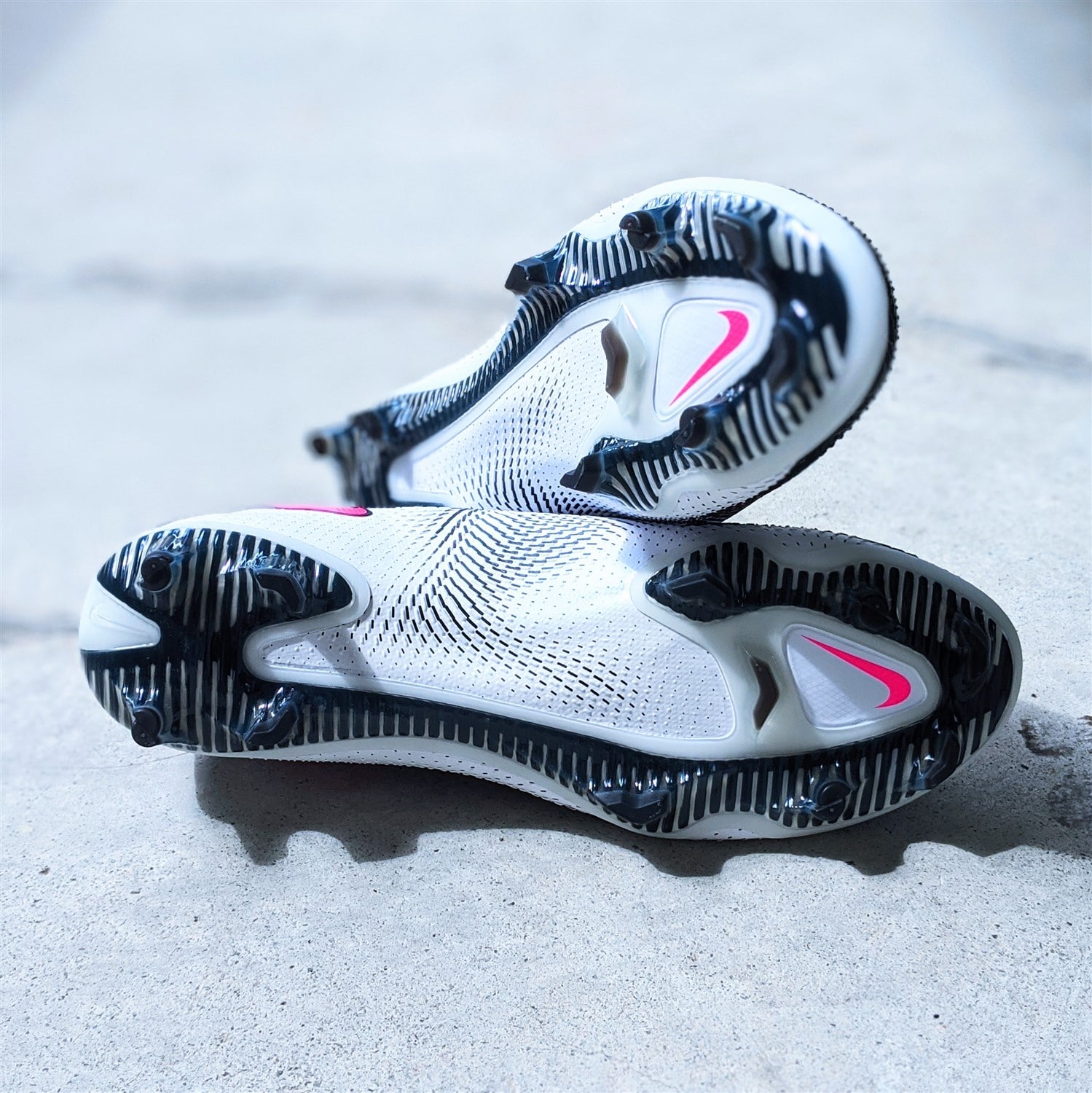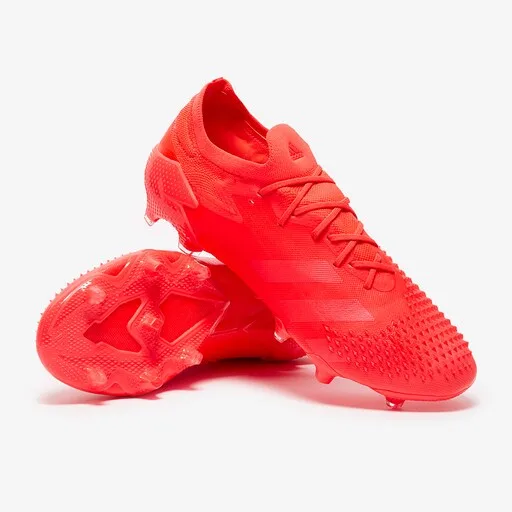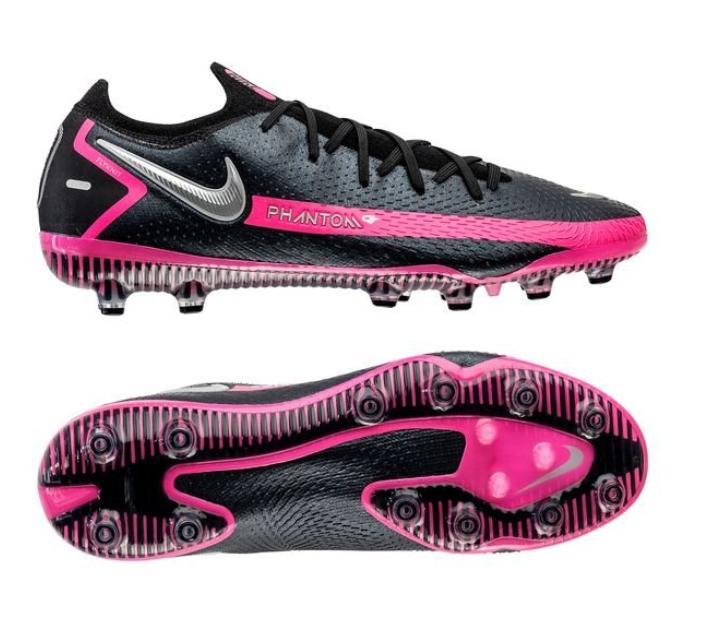We pit the 2 premier shooting boots in a head to head battle.
Perhaps my favourite evolution of how football boots are marketed is that we’ve increasingly moved away from “boots by position”. Unlike 5 years ago where you would be led to believe that you had to wear a certain model of boot as a defender, striker or midfielder, boots these days are more guided by your playstyle. If you love dribbling, go for the adidas X or the Nike Mercurial. Want amazing grip for smashing in those curled free kicks? The adidas Predator 20.1, and now the Nike Phantom GT, is your boot.
Both boots also offer a unique insight into how the brands look at improving your shot. The Predator 20.1 is developed with a fearsome-looking Demonskin upper and rubber spikes that actually add more grip to your shots. Conversely, the Phantom GT dropped its shot shield technology for a more minimalist upper, giving you a larger striking surface with very negligible grip elements to let your technique do all the talking.
For a fair battle, we’re comparing the low-cut versions of both models as we feel they’re the better versions of both models.


A narrow fit on the Predator while the Phantom GT cuts wide
Personally, this is the most important part of the boot. If there is too much room in the forefoot or toebox area, it’s much harder to get good contact with the ball when shooting or passing.
In this respect, both boots have similarly accommodating fits in the forefoot and I’d consider them to be on the wider spectrum in the football boot market. Where they differ is in the midfoot. The Predator 20.1 has a very narrow midfoot, which works excellently if you’ve got a higher arch. Thanks to the semi-split sole on the Phantom GT, which frees up the boot in the arch area, it has a wider and more accommodating fit – perfect for those with a flatter foot. If you’re one of those lucky ones with a perfect arch, don’t sweat it, you should be fine with both.


I did experience some issues with the heel areas in both boots potentially due to how my heel is shaped. The padding in the Predator 20.1 didn’t manage to hold my heel in and instead caused some slippage whereas the Phantom GT had the tendency to bite into my heel for some reason before I managed to break them in.
Sizing wise – go half size down for both boots. The due to how wide the Predator 20.1 is, going down half size gives you a better fit in the forefoot, both length and width wise. However, that also means a more narrow midfoot, which can take some time to break in.
With the Phantom GT, as we mentioned in our review, we detected a difference in fit between both launch colours (white and black) after trying them out in shops and corroborating with fellow reviewers. As such, we recommend going true to size for the black colourway and half size down in the white colourway if you have a wide foot. For players with a narrow or average width foot, go half a size down in the black colourway and consider skipping the white colourway entirely.
A dampened touch in the Predator, a barefoot feel in the Phantom GT
The touch on the ball is probably the next most important part of the boot and this is where both models begin to start to shine. The Predator 20.1’s Demonskin upper is probably the most uniquely designed upper out there in the market today. It has little to no foam under the upper and allows the rubber spikes to provide the “cushioning” effect. It’s a very unique sensation which feels barefoot, yet dampened at the same time. The rubber spikes do add a good amount of grip, so you may require some time getting used to it when you first start dribbling on the ball.


The Phantom GT’s upper also comes with no foam and is developed with a very thin layer of Flyknit, giving you an extremely barefoot touch. It feels even more barefoot than the Nike Mercurial Vapor 13.
I especially enjoyed the semi-split sole construction as it gave me a free sensation in the midfoot, and lets me feel more of the ball in that area.
A smashing good time shooting with both boots
This is the part you’ve all been waiting for – which the boots help you hit those top bins. Putting on the Predator 20.1 is an interesting experience. Once you get over the fit issues and break them in, you do get a sort of an “enhanced” feeling. Like Thanos attaching the Infinity Stones to his gauntlet and getting a power boost, you get that strange craving to just smash every ball as hard as possible ala Stevie G.


Despite the rubber spikes dampening some of the sting from the ball, you do feel quite a good connection with pinging or blasting the ball. I absolutely loved my time in it.
With the Phantom GT, it feels more straightforward. You don’t get any fancy sensations with it, just a good old foot to ball connection. With the off-centered lacing, you also get a nice feel of the ball when hitting those longer passes or 30 yard hammers with your “laces”. Lock in your ankles and get ready to let loose some rockets.
Curlers in the Predator, whip with venom in the Phantom GT
It’s not often that we focus on crossing alone but the difference in both boots’ construction made a major difference when bending it like Beckham.
Thanks to the semi-split sole design, my arch felt free and was better able to come into contact with the ball, especially around the midfoot. This meant that whipping in those quick De Bryune-esque crosses and free kicks felt much more natural as your foot is able to wrap around the ball more easily.


Where the Demonskin of the Predator 20.1 really shines is when you attempt to curl the ball. It’s not often that you can say a new football boot technology works, but damn do those rubber spikes add spin. adidas claims that there’s an additional 17% of spin added. I’m no scientist, but my shots do feel like there’s extra spin and curl to it. Though on days where my technique is slightly off, I do end up adding a little side spin to my pinged passes. It’s that aggressive.
Pro construction with the Predator, better movement in the GT
It’s been awhile since we’ve had a Nike football boot that works well on both FG and AG surfaces. I’m happy to report that both the Phantom GT and the Predator 20.1 work extremely well on the either surface.




The Predator 20.1 follows adidas’ tried and tested stud pattern and gets your decent traction. They reinforced the stroble (the internal structure between the outsole and the upper) with a stiff white plastic, a construction commonly done with pro boots, to provide extra stiffness and responsiveness. Personally, while I liked the added stiffness, I did change the insole to a more padded one to help offset the hardness of the plastic.
The Phantom GT on the other hand, has a good mix of split conical studs and bladed studs. The bladed studs are positioned for lateral movement, and you do feel additional bite when cutting and changing directions. This is probably my favourite soleplate on the market at the moment.
Picking the “better” boot comes down to personal preference
So which is the superior shooting boot? It comes down to your preferred playing style. Both boots fit and feel quite differently. The Predator is a more dampened and tighter fitting boot, while the Gt is a more natural feeling boot that will fit most foot types well enough.


If you’re the sort who likes to smash your shots into the top bins or add some finesse to those curled crosses, choose the adidas Predator 20.1. On the other hand, if you’re the sort who likes to whip in your crosses and loves a close touch on the ball, lace up in the Nike Phantom GT.


Shop the adidas Predator
adidas Predator Mutator 20.1 Low FG – Pop/White (grip battle)
Multiple stores


Shop the Nike Phantom GT
Nike Phantom GT Elite
Multiple stores



